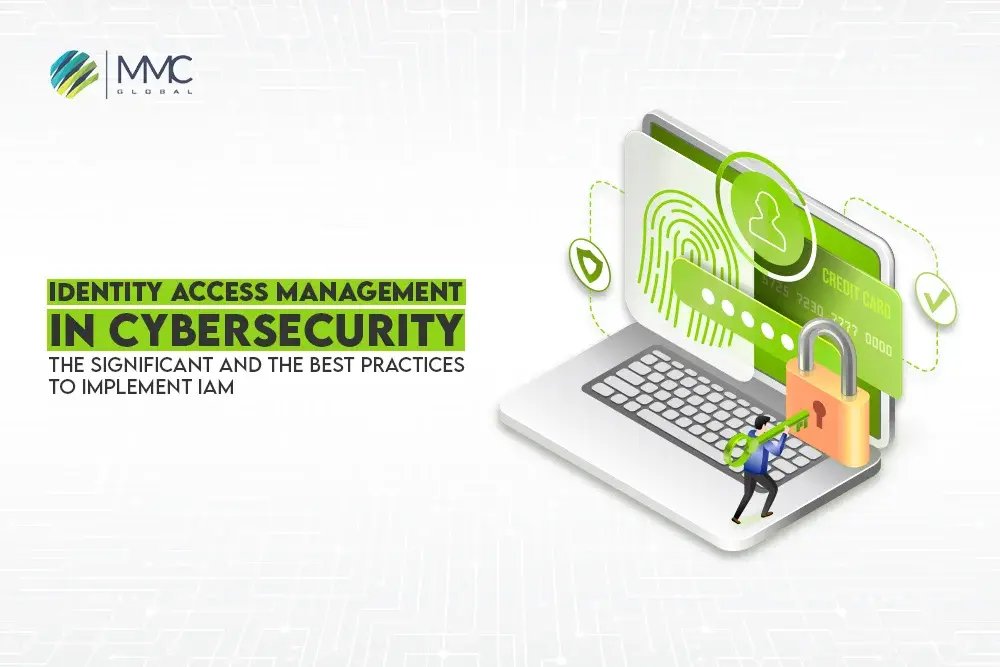Identity Access Management In Cybersecurity: The Significant And Best Practices To Implement IAM


Identity access management or IAM implementation in cybersecurity plays a vital role in managing and controlling user accessibility of a diverse range of systems and software. Organizations depend highly on software and ERP systems to centralize major operational tasks, sync different departments, and improve external and internal collaboration. Implementing a computational system and solution supports organizations’ dynamic functions and manages massive data repositories, including ordinary and confidential information.
Implementing digitization has many incredible benefits but also some critical risks. Securing the digital environment is as essential as implementing a digitized working environment. In fact, rising innovation requires strengthened security to tackle uncertainty and manage vulnerabilities. Today’s hackers also polish their skills using the latest technology and techniques.
Implementing essential measures to identity access management is instrumental in implementing interventions and mitigating the risk of cyber threats. This blog will discuss the concept of identity access management implementation and how it strengthened and maintained cybersecurity postures.
What is Identity Access Management?
Identity access management allows you to manage and control user access using a policy and technology framework. It helps ensure that the correct user has access to the technology resources. Moreover, the identity access management framework’s appropriate implementation helps keep hackers away from your computational system and software. Implementing IAM is like locking the door and giving the key only to concerned people; no one is allowed to enter there unless you give permission.
To refrain from dangerous hacking tactics, organizations need to dive deeper into cybersecurity standards to meet the latest requirements. For example, preventing user credentials, promoting secure logins, and assigning user roles can help organizations improve the security of software systems.
In this uncertain digital evolution condition, organizations need to improve implementation. In fact, 95% of cybersecurity incidents at SMBs cost between $826 and $653,587. Additionally, 80% of all hacking incidents involve compromised credentials or passwords.
Hackers can reach your confidential credentials by creating diverse technical issues with your computer and hijacking critical information without knowing it. Data is the key to every business, whether it is related to customers/clients or the company itself. Weak cybersecurity aims to attack all critical information that can exploit the organization’s reputation for financial gains. They can make money by ransomware or selling your data to other hackers on the dark web. There is so much associated with cyberattacks that you can expect.
What Major Steps Need To Take While Implementing IAM
The most effective approach to channelling identity access management is to create an effective identity access management strategy that includes a human workforce and smart software. Any organization can not rely on automated processes or software; human supervision with an effective strategy is a must.
A dedicated resource should align who should monitor user accessibility within the organization. There should be a process to circulate during provisioning and deprovisioning. When a new employee is onboard, understanding which software he requires is fundamental. Similarly, when an employee leaves, the office must take over all the access from him, which they can use to run operations internally and externally during their employment tenure.
Moreover, your company needs a process to determine who is responsible for shutting down all the digital system access, identify what application and software they could access, take over all essential credentials before leaving, and deactivate all single sign-on or separate sign-on for different systems.
Almost every company and institution has hundreds of different solutions, including vendor portals, payment systems, mobile applications, employee management systems, client portals, and ERPs that use single sign-on. Some institutions, like banking and healthcare, do not work on single sign-on, making it difficult to manage identities for an extensive number of employees.
Best Practices For Creating Effective Identity Access Management Policy
Creating an Identity and Access Management (IAM) policy is crucial for securing your organization’s resources. Here are some best practices to consider:
Principle of Least Privilege
Only give users the minimum access necessary to perform their tasks. Avoid granting broad permissions like “AdministratorAccess” unless necessary. Review and update policies to ensure permissions are still necessary and aligned with user roles.
Use Managed Policies
Where possible, use AWS-managed policies or those provided by your cloud provider. They are maintained and updated regularly to incorporate best practices and new services.
Role-Based Access Control (RBAC)
Assign permissions based on roles rather than individuals. This simplifies management and ensures users have the correct permissions for their job functions. For instance, create roles for “read-only access” or “developer access” and attach these roles to users.
Avoid Wildcard Permissions
Avoid using wildcards (*) in resource or action specifications. Instead, specify the exact actions and resources users need to access. Apply conditions to permissions to restrict further access based on IP addresses, MFA usage, or time of day.
Multi-Factor Authentication (MFA)
Require MFA for all users, especially those with privileged access. This adds an additional layer of security beyond just passwords.
Use Inline Policies Sparingly
While inline policies can be helpful in specific scenarios, they should be used sparingly. Managed policies offer better reusability and management.
Regular Auditing and Monitoring
Log and monitor tools like AWS CloudTrail or Azure Monitor to track identity access management activities. Regularly audit IAM policies and access logs to detect and respond to unauthorized access. You can also set up automated alerts for unusual or unauthorized access attempts.
Other Practice That You Can Implement
- Use Resource-Based Policies
Apply policies directly to resources like S3 buckets or EC2 instances to control access at the resource level. This can complement user-based identity access management policies.
- Policy Versioning and Documentation
Keep detailed records of policy changes, including who made the change and why. Version policies to keep track of changes over time.
- Test Policies
Use tools like the AWS identity access management Policy Simulator to test policies’ effects before deploying them. This can help you avoid accidentally granting too much access.
- Limit Use of Root Account
The root account should only be used for tasks that require root privileges. For everyday tasks, use an identity access management user with appropriate permissions.
- Educate and Train Users
Regularly educate your team on the importance of identity access management best practices and the specific policies that apply to them.
Get Information about: How To Mitigate Cybersecurity Threats From Insurance Industry
How MMC Global Can Help You In IAM Implementation
MMC Global is a leading IT and cybersecurity company that helps businesses of all sizes identify the need for IT solutions, execute the implementation, and secure the system from all vulnerabilities. We specialize in creating IAM policies and help you implement a streamlined roadmap of the identity access management process within your organization.
Moreover, we can also help audit your system security, conduct pen-testing, and take precautionary measures to mitigate the risk of any casualties. Our expert cybersecurity consultant encourages businesses to go digital without fearing cyber threats and cyberattacks because we provide robust solutions that overcome all your security challenges.



